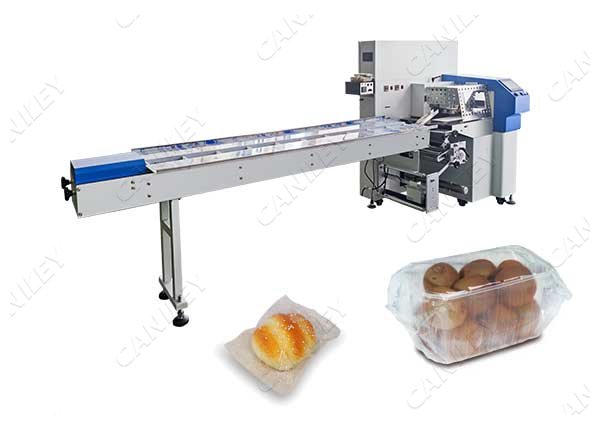What Is The Working Principle of Horizontal Flow Wrap Machine?
- Release Lime: Sep 25 2023
- Source: Sherry
Horizontal flow wrap machines are integral to the packaging industry, enabling the efficient and uniform packaging of various products. These machines are commonly used for packaging items like chocolates, candies, cookies, soap bars, and many others. But do you know what is the working principle of horizontal flow wrap machine?

The basics of horizontal flow wrap machines:
A horizontal flow wrap machine is designed to wrap products in a continuous, tight, and secure manner by using a flexible packaging material, typically a roll of film. The process involves several key components and stages:
Film unwinding:
The process begins with the unwinding of a roll of packaging film, which is positioned above the machine. The film is pulled downward towards the product loading area.
Product loading:
The products to be wrapped are manually or automatically fed into the machine's loading conveyor. These products are spaced uniformly to ensure consistent packaging.
Film forming:
As the film travels down from the film roll, it passes through a series of forming devices that create a "Tube" From the flat film. The product is positioned in the center of this formed film.
Sealing:
The horizontal flow wrap machine uses heat sealing bars or wheels to create longitudinal seals along the sides of the film. These seals ensure that the product is enclosed within the film.
Cutting:
After sealing, a cutting mechanism, often a rotary knife or blade, separates the wrapped product from the film roll. The cutting process is synchronized with the machine's speed to maintain consistent packaging dimensions.
End sealing:
In some cases, horizontal flow wrap machines also have devices for creating end seals at both ends of the product. These seals further secure the product within the packaging.
Product discharge:
Once wrapped and sealed, the products exit the machine on a conveyor for further processing or packing.
Key principles and advantages
The working principle of horizontal flow wrap machines is based on precision, speed, and automation. Here are some key principles and advantages:
1. Versatility:
Horizontal flow wrap machines can handle a wide range of product sizes and shapes, making them suitable for various industries.
2. Efficiency:
These machines operate at high speeds, making them ideal for mass production and achieving economies of scale.
3. Tight seal:
The heat sealing process ensures a secure and tamper-evident seal around each product.
4. Reduced material waste:
By using a continuous roll of film, horizontal flow wrap machines minimize material wastage compared to pre-cut packaging.
Horizontal flow wrap machines play a crucial role in modern packaging operations, offering efficiency, consistency, and versatility. Understanding their working principle is essential for businesses seeking to streamline their packaging processes and deliver products securely to consumers. These machines continue to evolve, incorporating advanced automation and technology to meet the ever-changing demands of the packaging industry.

The basics of horizontal flow wrap machines:
A horizontal flow wrap machine is designed to wrap products in a continuous, tight, and secure manner by using a flexible packaging material, typically a roll of film. The process involves several key components and stages:
Film unwinding:
The process begins with the unwinding of a roll of packaging film, which is positioned above the machine. The film is pulled downward towards the product loading area.
Product loading:
The products to be wrapped are manually or automatically fed into the machine's loading conveyor. These products are spaced uniformly to ensure consistent packaging.
Film forming:
As the film travels down from the film roll, it passes through a series of forming devices that create a "Tube" From the flat film. The product is positioned in the center of this formed film.
Sealing:
The horizontal flow wrap machine uses heat sealing bars or wheels to create longitudinal seals along the sides of the film. These seals ensure that the product is enclosed within the film.
Cutting:
After sealing, a cutting mechanism, often a rotary knife or blade, separates the wrapped product from the film roll. The cutting process is synchronized with the machine's speed to maintain consistent packaging dimensions.
End sealing:
In some cases, horizontal flow wrap machines also have devices for creating end seals at both ends of the product. These seals further secure the product within the packaging.
Product discharge:
Once wrapped and sealed, the products exit the machine on a conveyor for further processing or packing.
Key principles and advantages
The working principle of horizontal flow wrap machines is based on precision, speed, and automation. Here are some key principles and advantages:
1. Versatility:
Horizontal flow wrap machines can handle a wide range of product sizes and shapes, making them suitable for various industries.
2. Efficiency:
These machines operate at high speeds, making them ideal for mass production and achieving economies of scale.
3. Tight seal:
The heat sealing process ensures a secure and tamper-evident seal around each product.
4. Reduced material waste:
By using a continuous roll of film, horizontal flow wrap machines minimize material wastage compared to pre-cut packaging.
Horizontal flow wrap machines play a crucial role in modern packaging operations, offering efficiency, consistency, and versatility. Understanding their working principle is essential for businesses seeking to streamline their packaging processes and deliver products securely to consumers. These machines continue to evolve, incorporating advanced automation and technology to meet the ever-changing demands of the packaging industry.

 0086-15515573212
0086-15515573212 info@cankeytech.com
info@cankeytech.com



 Your Location:
Your Location: